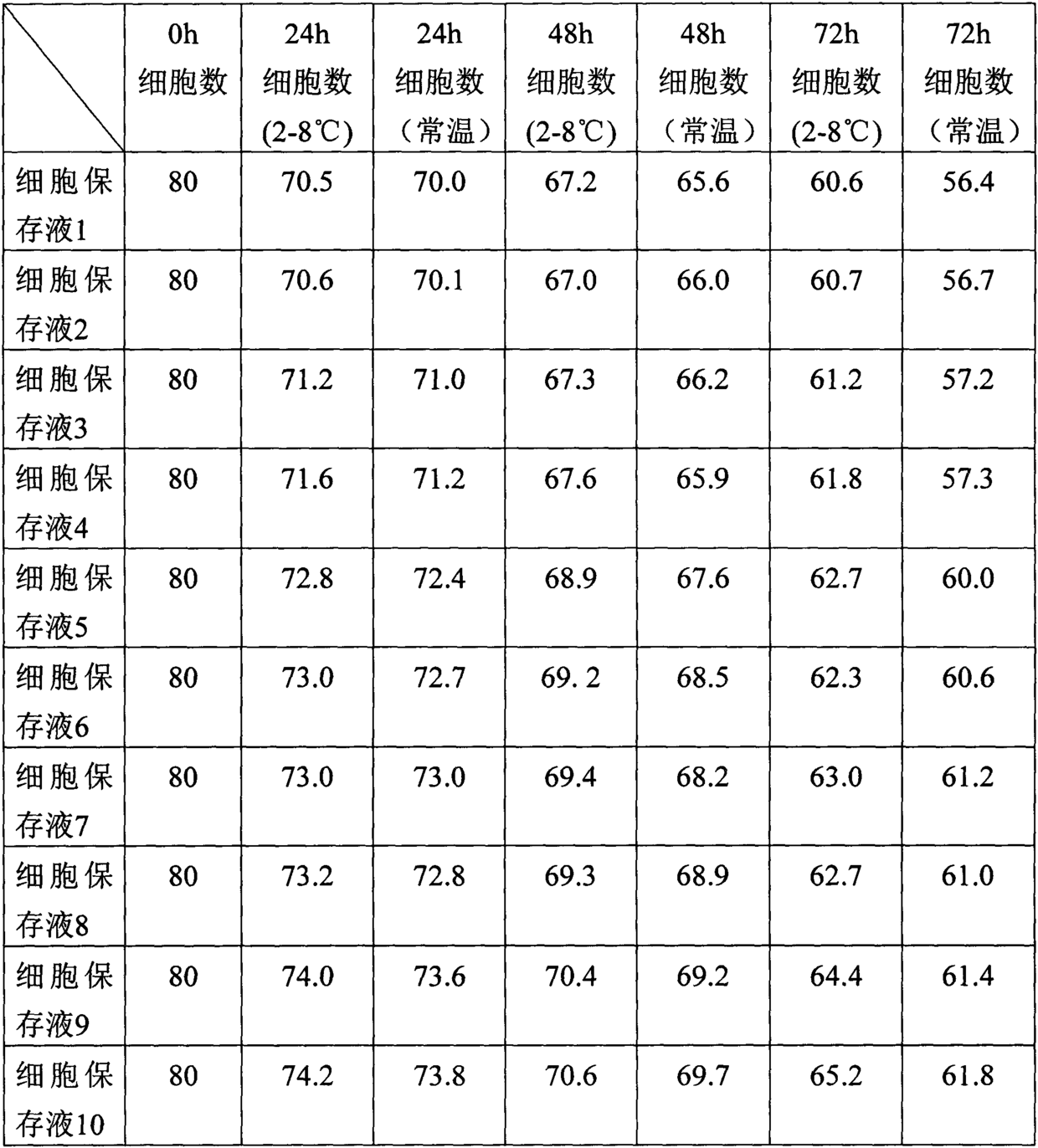Cell preservation solution and use thereof
A technology for preserving liquids and cells, applied in the field of biology, to achieve strong acid-base buffering capacity, avoid cell damage, and simple cell transportation
- Summary
- Abstract
- Description
- Claims
- Application Information
AI Technical Summary
Problems solved by technology
Method used
Image
Examples
Embodiment 1
[0029] The preparation method of embodiment 1 cell preservation solution
[0030] The cell preservation solution used in the following examples uses the same preparation method, specifically as follows:
[0031] Add electrolytes to 900ml of deionized water, stir and dissolve on a magnetic stirrer, then add various amino acids, stir and dissolve, add HEPES, glucose, trehalose, L sodium ascorbate and antioxidants, fully dissolve, add water to 1L, Adjust the pH to 7.2-7.5. Sterilize by filtration using a disposable cup filter with a 0.22 μm filter membrane (Thermo Scientific, Cat. No. 5954520).
Embodiment 2
[0032] Example 2 Cell Preservation Solution 1
[0033] Cell preservation solution 1, containing electrolytes, amino acids, 5mM hydroxyethylpiperazineethanesulfonic acid (HEPES), 5.5mM glucose, 0.01M trehalose, 50mg / L L sodium ascorbate, and 50μM MnTBAP;
[0034] The electrolyte components are: NaCl 6g / L, KCl 0.2g / L, NaCl 2 HPO 4 0.06g / L, NaH 2 PO 4 0.04g / L, MgCl 2 ·6H 2 O 0.1g / L, MgSO 4 0.04g / L, CaCl 2 0.1g / L, CuSO 4 ·5H 2 O 0.001mg / L, ZnSO 4 ·7H 2 O0.33mg / L, NaHCO 3 1.2g / L.
[0035] The amino acid composition is: L-alanine 0.1g / L, L-arginine 0.4g / L, L-asparagine 0.2g / L, L-cysteine 0.1g / L, L-glutamine Aminoamide 0.2g / L, Glycine 0.1g / L, L-Histidine 0.2g / L, L-Isoleucine 0.1g / L, L-Leucine 0.1g / L, L-Methionine 0.05g / L L, L-phenylalanine 0.1g / L, L-serine 0.1g / L, L-threonine 0.2g / L, L-tryptophan 0.01g / L, L-tyrosine 0.2g / L , L-valine 0.05g / L.
Embodiment 3
[0036] Example 3 Cell Preservation Solution 2
[0037] Cell preservation solution 2, containing electrolytes, amino acids, 20mM hydroxyethylpiperazineethanesulfonic acid (HEPES), 24.5mM glucose, 0.05M trehalose, 100mg / L L sodium ascorbate, and 10μM MnTMPyP;
[0038] The electrolyte components are: NaCl 8g / L, KCl 0.4g / L, NaCl 2 HPO 4 0.08g / L, NaH 2 PO 4 0.06g / L, MgCl 2 ·6H 2 O 0.3g / L, MgSO 4 0.06g / L, CaCl 2 0.13g / L, CuSO 4 ·5H 2 O 0.002mg / L, ZnSO 4 ·7H 2 O0.53mg / L, NaHCO 3 2.8g / L.
[0039] The amino acid composition is: L-alanine 0.3g / L, L-arginine 0.6g / L, L-asparagine 0.3g / L, L-cysteine 0.14g / L, L-glutamine Aminoamide 0.8g / L, Glycine 0.3g / L, L-Histidine 0.3g / L, L-Isoleucine 0.15g / L, L-Leucine 0.15g / L, L-Methionine 0.1g / L L, L-phenylalanine 0.15g / L, L-serine 0.3g / L, L-threonine 0.4g / L, L-tryptophan 0.03g / L, L-tyrosine 0.4g / L , L-valine 0.15g / L.
PUM
 Login to View More
Login to View More Abstract
Description
Claims
Application Information
 Login to View More
Login to View More - R&D
- Intellectual Property
- Life Sciences
- Materials
- Tech Scout
- Unparalleled Data Quality
- Higher Quality Content
- 60% Fewer Hallucinations
Browse by: Latest US Patents, China's latest patents, Technical Efficacy Thesaurus, Application Domain, Technology Topic, Popular Technical Reports.
© 2025 PatSnap. All rights reserved.Legal|Privacy policy|Modern Slavery Act Transparency Statement|Sitemap|About US| Contact US: help@patsnap.com


